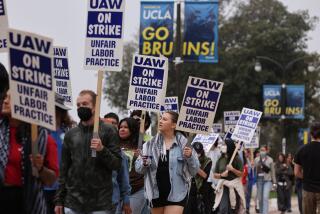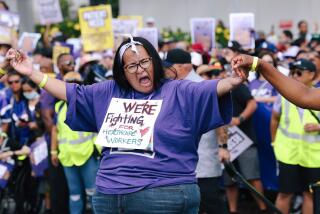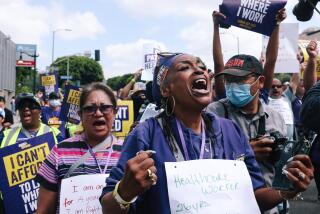March smaller, but festive
- Share via
Thousands of workers waved American flags, marched to mariachi music and rallied for labor and immigrant rights in downtown Los Angeles on Thursday, as May Day gatherings drew light but peaceful crowds.
Turnout across Southern California and the nation was markedly lower than in the last few years, when millions of marchers in more than 100 cities hit the streets on May Day to urge a path to citizenship for illegal immigrants and other reforms.
In Los Angeles, where about 8,500 people took part in three separate marches that merged to rally at 1st Street and Broadway, some participants said fear of government raids and growing apathy about pros- pects for change had dampened turnout. About 20,000 had been expected to participate.
“A lot of people feel that nothing is being done,” said Xochilt Pacheco, 30, a Mexican American from Highland Park whose father is an illegal immigrant. She wore a white dress with the slogans “We are workers, not criminals” and “Legalize me” printed in red letters. “We march and nothing is done. We march and there are raids,” she said.
Others said the lower turnout was a reflection of the immigrant rights movement’s shift in focus from marches to voter registration and other civic activities; a decision not to push boycotts of school and work this year; and a preoccupation with contract negotiations and other issues. Unlike in past years, the Service Employees International Union Local 1877 and the We are America Alliance, a coalition of churches, labor unions and community groups, were not heavily involved in organizing this year’s marches.
“This year, we’re focusing on civic engagement work,” said march participant Angelica Salas, executive director of the Coalition for Humane Immigrant Rights in Los Angeles.
On that front, immigrant rights advocates say they have won considerable success. The number of citizenship applications had doubled to 1.4 million by the end of fiscal year 2007 compared to the previous year, according to Rosalind Gold of the National Assn. of Latino Elected and Appointed Officials Educational Fund in Los Angeles. The number of Latinos registered to vote in California had increased by 13%, nearly triple the non-Latino rate, in April 2008 compared to the previous year.
The May Day marches, which historically commemorate International Workers’ Day, have been specifically used in Los Angeles to celebrate the contributions of the immigrant workers who make up nearly half of the county’s workforce. They took place amid continuing fierce debate over immigration reform proposals, which have stalled in Congress.
The battle over what to do about the nation’s estimated 12 million illegal immigrants has prompted hundreds of state and local legislative proposals, colored the presidential campaign and brought tens of thousands of marchers into the streets nationwide in the last two years.
While turnout was light this year, the mood was festive at the Los Angeles marches’ three downtown area departure points.
At MacArthur Park, vendors hawked noisemakers, American and Mexican flags and bacon-wrapped hot dogs as Aztec performers danced on a makeshift stage and musicians competed for attention.
At Olympic Boulevard and Broadway, a loud mariachi band led about 1,500 people in an early afternoon procession north to the Civic Center as activists handed out fliers and pushcart owners offered sweating marchers Popsicles, fruit and shaved ice.
While the largely Latino crowd occasionally chanted in Spanish -- “si se puede,” yes we can -- immigrants from South Korea, the Philippines, Japan and elsewhere also participated.
“I think it’s really important for us to show the broad span of immigrants in Los Angeles,” said Bev Tang of Silverlake, of the Filipino youth group Anakbayan. “Filipino immigrants are out here and are part of the struggle.”
Rick Oltman, spokesman for the anti-illegal immigration group Californians for Population Stabilization, criticized marchers’ calls for a moratorium on raids.
“It is reminding the American people that there is this whole group of people, illegal aliens, who do not want our laws enforced,” he said.
But marchers included many legal immigrants. Andres Rivas, 68, a former El Salvador city mayor who received amnesty in the 1980s and is now a naturalized U.S. citizen, said he marched to support those who are still fighting for legal status. He said he was helped by those who fought for him and now, “we have to stand up for those who don’t have it today.”
Participants also included some of those injured in last year’s MacArthur Park melee, when Los Angeles Police Department officers confronted marchers and journalists in a botched attempt to clear out the crowd. One of them was Doris Ochoa, a 40-year-old janitor and illegal immigrant from Mexico, who wore a red shirt and marched near the front of the line with other victims. She said she and her two sons, now 5 and 14, were hurt last year while running from police on motorcycles. Ochoa, who has filed a lawsuit against the city, said she still can’t understand why police hurt peaceful protesters.
“Why did they treat us like that?” she said. “They acted in a way officials shouldn’t. It’s important to show . . . that we are still standing.”
Police reported no major problems Thursday and seemed to be taking extra care to be cordial. Officers on foot, bicycle and horseback -- many of whom participated in special training exercises to avoid last year’s problems -- appeared relaxed and chatted with marchers, politely addressing them on loudspeakers:
“Hello. Welcome to your May Day march. Please move to the sidewalk.”
Meanwhile, Los Angeles Unified School District officials reported that 743 students walked out of classes Thursday, a steep drop from the 26,000 students in 2006 and 1,600 last year.
Gustavo de Jesus, 17, showed up at David Starr Jordan High School but left before classes began. De Jesus, an illegal immigrant, said he wants to go to college but doesn’t know if he will be able to get scholarships to afford it. And even if he does, he worries that he will still end up working construction or at a fast food restaurant because he doesn’t have immigration papers.
“I’ve been here my whole life,” he said. “I love this country.”
Reflecting the day’s focus on comprehensive reform and ending immigration raids, a contingent of workers from a Van Nuys factory that was raided in February joined the march. Maria Guandique, 34, was arrested on suspicion of civil immigration law violations when she was working as an assembler at Micro Solutions Enterprises. Unable to work, she has had trouble paying rent and has had to seek help from her church.
“They’re treating me like I’m a criminal, and I’m not,” she said, lifting her slacks to show the ankle bracelet that authorities are using to monitor her whereabouts 24 hours a day.
Their calls for legalization and an end to blanket work-site raids were joined Thursday by some powerful allies: business leaders.
At a May Day news conference, Los Angeles Area Chamber of Commerce President Gary Toebben said the government should concentrate its limited resources and enforcement efforts on those companies with a clear history of exploitation of workers.
Work-site raids have swelled in recent years, with 4,900 arrests in fiscal 2007, a 45-fold increase over 2001, according to the U.S. Immigration and Customs Enforcement Agency.
Toebben was joined by Jack Kyser, chief economist for the Los Angeles County Economic Development Corp., which released a study showing that tens of thousands of jobs and millions of dollars in revenue could be lost if continued raids force businesses to flee the state.
The study analyzed three industries thought to employ high numbers of immigrant workers -- fashion, food processing and furniture manufacturing -- and found that about 10,000 businesses created nearly 500,000 direct and indirect jobs and produced $18.3 billion in wages in 2006. If 15% of those firms left the region would lose nearly 75,000 jobs, the report found.
“We can’t afford any more of these raids,” Kyser said, adding that recruiters from Washington state and elsewhere have begun aggressively courting businesses to relocate.
But Immigration and Customs Enforcement spokeswoman Virginia Kice said it was the agency’s “sworn duty to enforce our nation’s immigration and customs law and the agency is going to aggressively pursue that mandate.”
--
--
-
--
Times staff writers Tony Barboza, Howard Blume, Jessica Garrison, Evelyn Larrubia, Jill Leovy, Rong-Gong Lin II, Robert Lopez, Sam Quinones and Joel Rubin contributed to this article.
More to Read
Sign up for Essential California
The most important California stories and recommendations in your inbox every morning.
You may occasionally receive promotional content from the Los Angeles Times.











